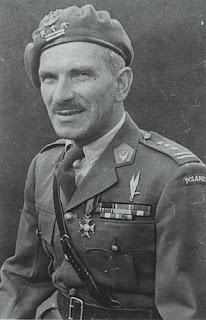 |
| General Stanislaw Sosabowski |
No other Allied General during World War II had been so villified and ostracized by British Command as General Stanislaw Franciszek Sosabowski. He was Commander of the Polish 1st Independent Parachute Brigade which fought valiantly in Operation Market Garden, a battle which ended with disastrous casualties of allied troops including the Polish division. Sosabowski attempted to divert disaster by warning British command of their flawed strategy but it was not heeded nor tolerated and ultimately resulted in a swift and humiliating dismissal from his command. Sosabowski was a brilliant strategist with an illustrious career in the military yet British command made him a scapegoat so as to avoid admitting their own culpability in the tragic debacle.
To the rest of the world the name Stanislaw Sosabowski has since faded into virtual obscurity, that is until 2007 when a Polish documentary was produced that finally exposed the slander and libel that has tarnished the legacy of a great man and a great General. The film, Honor Generala (A General's Honor) has succeeded in restoring honour to his name, and to the men that served his unit. (video at end of post)
Stanislaw Sosabowski was born on May 8, 1892 in Stanislawow. At the time, Poland was under foreign occupation having been partitioned in 1772 by the imperial powers of Russia, Prussia and Austria. It was one of three partitions that virtually obliterated the Polish state for 123 years. Stanislowow is now part of the Ukraine which is now called Ivano-Franivsk. Before the partitions, the city of Stanislawow was a private fortress that had been built in the 17th century by the Potocki family and owned by them until they were constrained to relinquish it to the House of Habsburg. (Incidentally, the Potocki name comes from a long line of Polish aristocratic land-owners whose legacy has been indelibly intertwined with the Polish history and culture of the region.)
Sosabowski's early life was one of struggle and self-sacrifice. He was one of four children - two boys and two girls but Stanislaw Andrzej Janina and Kazimiera died at a young age. His father worked as a railway clerk. In 1910 Sosabowski was accepted by the Faculty of Economics at the University of Krakow but when his father passed away he abandoned his studies and returned to Stanislawow to assume the responsibilities of caring for his family, working as a bank clerk.
 |
| Polska Druzyna Strzelecka |
By 1913 Sosabowski had been drafted into the Austro-Hungarian army and soon after having completed his training was promoted to the rank of Corporal in the 58th Infantry Division. He led his unit into battle when World War I broke out and fought with great distinction in the Battles of Rzeszow, Dukla Pass and Gorlice.
Sosabowski helped to defend the Austrian fortress city of Przemysl and was one of the only three survivors of a total company of 250 men. He was decorated with numerous medals for his bravery and service and rose to the rank of First Lieutenant. But in 1915 Sosasbowski was badly wounded in action and had to withdraw from the front. He spent many months in hospital with Maria Tokarska at his side, whom he later married.
In 1917 Sosabowski was promoted to the rank of 2nd Lieutenant but because of his war wounds he was instead appointed to Staff Officer of the Archduke Franz Josef HQ in Tyrol. His first son, Stanislaw Janusz was born in Brno.
When Poland regained it's independence on November 11, 1918 Sosabowski pledged allegiance to the re-emerged Polish State. He was made Captain of the new Polish Army and organized the disarming of Ukrainian soldiers, and former units of the Austrian army. Sosabowski and his family took up residence in Zoliborz - a very upscale district of Warsaw - then and now. From 1919-20 he worked at the Ministry of Army Affairs in Warsaw as materiel and supplies specialist and also served as member of the Polish Mission to the Inter Allied Council in Spa, Belgium. (He was fluent in French.)
Following the end of the Polish-Soviet War, Sosabowski was promoted to the rank of Major. In 1922 he attended the Wyszwsz Szkola Wojskowa in Warsaw, the Polish Army General Staff College - prestigious institutions accessible only to a privileged few. Among his classmates was Przedrzymirski Heller Ulrich who would later achieve very high military stature. During this time Sosabowski's second son, Jacek was born. The family house, located at 11 Josef Haukiego Street, was constructed in grand style consisting of basement, two floors and a large garden. (It's market value today is in the millions.)
In 1928 he was promoted to rank of Lieutenant Colonel of the 75th Regiment at Chorzow, and at Rybnik, and then made Deputy Commanding Officer of the 3rd Podhale Rifle Regiment, an elite infantry division.
From 1930 to 1936 he served as lecturer and head of the Polish General Staff College, and during that time published two books which have since become standard for military texts. After a prolonged absence he finally returned to the front line as CO of the 9th Infantry Regiment of the 3rd Infantry Division in Zamosc. Just at that time, tragedy struck and his younger son Jacek had died in a horrible accident.
In 1937 he was promoted to the rank of Colonel and was appointed commanding officer of the 9th Polish Legions Infantry Regiment in Zamosc. Two years later he was given command of the prestigious 21st "Children of Warsaw" Infantry Regiment. (Dzieci Warszawy)
 |
| Schleswig Holstein fires first shots of WWII |
Sosabowski's unit, attached to the 8th Infantry Division had reached the Modlin Fortress by September 8 and after several days of defensive battles, the unit headed towards Warsaw 50 kilometers away. As soon as they arrived, Sosabowski's regiment was ordered to defend Grochow, Kamionek and Praga against the Nazi 10th Infantry Division.
During the Siege of Warsaw, Sosabowski and his men, against all odds managed to maintain their objectives. When the Germans launched a general assault on Praga, the Polish infantry succeeded in not only repelling their attacks but conducted successful counter-attacks and destroyed many enemy troops. Warsaw capitulated on September 29 but despite the overwhelming power of the German war machine Sosabowski and his men managed to keep fighting the enemy until the end of September. General Juliusz Rommel awarded Col. Sosabowski and the entire company of 21st Infantry Regiment with the highest military decoration for bravery, the Virtuti Militari.
Sosabowski was taken prisoner and interned at a German camp near Zyradow, but luckily he managed to escape and returned to Warsaw under an alias and joined the Polish resistance ready to continue fighting. But he was ordered to leave Poland immediately and head for France with important documents detailing the situation in Nazi-occupied Poland and set out on a long and perilous journey through Hungary and Romania. Once having arrived in Paris, the Polish government in exile appointed Sosabowski as commanding officer of the Polish 4th Infantry Division.
At first the French authorities were reluctant to provide the Polish unit with equipment and armaments but eventually cooperated albeit with equipment that predated World War I. In April 1940 the Polish division had been moved to a training post at Parthenay and were supplied with weapons they had been expecting since January, but only 3,150 weapons were available to distribute among the 11,000 soldiers. Time was running out. The Germans invaded in May and France fell. The commander of the unit, General Rudolf Dreszer,ordered the troops to withdraw to the Atlantic coast. On June 19, 1940 Sosabowski and his men were among the 6,000 Polish soldiers who made their way to La Pallice to evacuate to Great Britain.
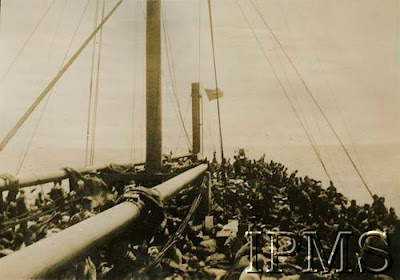 |
| Polish soldiers evacuation by boat presumably from France to England 1940 |
The Polish General Staff in London assigned Sosabowski the command of the 4th Rifles Brigade. Recruits were mainly young Polish men from Canada, and it became quickly apparent that there were not enough men with which to create a division. Sosabowski envisaged a transformation of his unit into that of a specialist parachute brigade - the first of its kind in the Polish Army. Soon recruits were flooding in from all sectors of the Polish Army and a parachute training camp was established at Largo House.
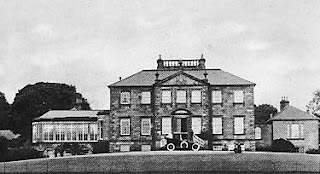 |
| Largo House Fife Scotland - Training Camp of Polish paratroopers |
Sosabowski joined his men in the training schedules and passed the tests. At the age of 49 he made his first parachute jumps. Their objective was to assist in the national uprising in Poland and were planning to be the first wave of the troops from the Polish army-in-exile to reach the fatherland. Their motto was Najkrotsza Droga, the Shortest Way. The unit was named the 1st Independent Parachute Brigade and by October 1942 they were ready for combat.
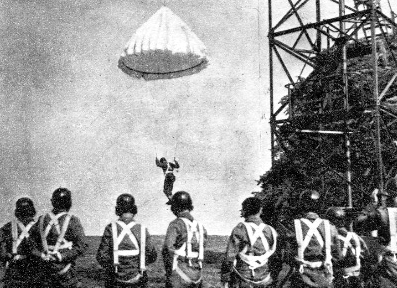 |
| Polish paratroopers training ( Special Cichociemni forces) |
After years of covert preparation, the Armia Krajowa (Home Army) launched the Warsaw Uprising on August 1, 1944. British authorities had been notified in advance, and the expectation was quite high among Polish troops that the British would provide military assistance and supplies to the Home Army at the appropriate time. The 1st Independent Parachute Brigade was at the ready to drop over Warsaw and fight alongside their colleagues. However British Command, loyal to their new ally, Stalin, would not allow Sosabowski's men to provide assistance to the Warsaw defenders. British authorities insisted that the mission would be jeopardized because transport aircraft could not make a round trip of such a great distance. The awful truth was that Stalin denied them access to Soviet airfields.
The bad news impacted the Polish troops quite severely and they were on the verge of a mutiny. When British Command threatened the Polish unit with disarmament, Sosabowski had to resume control of his unit. The Polish Commander-in-Chief Kazimerz Sosnkowski had no choice but to put the brigade under the authority of British Command - and the hopes and plans of the 1st Independent Parachute Brigade were crushed. Instead of fighting for their own country, they were compelled to fight at Arnhem.
OPERATION MARKET GARDEN - BATTLE AT ARNHEM
The Battle of Arnhem (September 17-26, 1944) was an ambitious project proposed by Field Marshal Montgomery albeit an unsuccessful one - to bypass the Siegfried line and attack directly into the industrial heartland of Germany through the Rhine. Originally he had planned to launch Operation Comet, which would combine the forces of the 1st Airborne Division and the 1st Polish Independent Parachute Brigade. However, on September 10th the Operation had to be scrapped because of bad weather having lasted for several days, as well as concerns by Montgomery of increasing German resistance in the area.
An allied victory was greatly anticipated as well as the expectation of shortening the war by several months. It was the largest airborne operation yet devised combining the airborne divisions of the US 101st and 82nd, the British 1st and the 1st Polish Independent Parachute Brigade, as well as land forces including the XXX Corp. Major-General Urquhart was given command of the British and Polish divisions. The mission's tactical objectives called for the capture of several bridges across the Maas, securing the Waal and the Lower Rhine in addition to several canals and tributaries - the most important of which was the Arnhem Bridge. While the allied had initial success, it was minimal.
Though British Command was fervently optimistic, the mission was doomed to failure. Despite numerous warnings from General Sosobowski, which was supported by Major-General Urquhart and other officers, plans went ahead anyway for the invasion.
 |
| L-R: General Sosabowski and Browning |
Browning believed that German resistance would be minimal, but in reality Arnhem was heavily defended by German panzer divisions. Major Urquhart, Browning's intelligence officer, ordered an aerial reconnaissance which confirmed it, but General Browning chose to ignore the report and ordered Urquhart on sick leave. From the start there was considerable disagreement between General Sosabowski and Browning regarding the Operation's strategy but no amount of reasoning could persuade Browning of this folly.
 |
| Allied Landings - Operation Market Garden - Battle of Arnhem |
A massive aerial armada commenced on September 17, 1944, transporting thousands of personnel and equipment from Britain to Holland. But instead of flying several sorties and dropping all paratroopers on one day, the second contingent was dropped only the next day. With Operation Market Garden already underway, the Polish 1st Independent Parachute Brigade was still in England, it's departure postponed due to bad weather and heavy fog. To compound the difficulties, the Brigade's artillery had been dropped with the 101st while the howitzers were being shipped by sea - a scenario which made it virtually impossible for the Polish forces to function effectively.
 |
| Polish soldiers of the 1st Polish Independent Parachute Brigade boarding plane |
Because of a severe shortage of transport planes the Polish brigade had to be split up into separate contingents. On September 19 two of the brigades' three battalions were dropped opposite the position of the 1st Airborne Division south of the Rhine near Driel and the remainder were to arrive two days later at a distance town, Grave. It was a suicide mission. Many paratroopers dropped right into enemy territory and were cut down by a barrage of heavy gun fire.
Polish troops were called in to provide reinforcements to the besieged 1st Airborne Division, however they had no choice but to withdraw to Driel. The opposite bank of the river was heavily reinforced by Germans, and the ferry that the British thought was available had been sunk and was unsalvageable. The Polish Brigade were ordered to make the crossing using small rubber boats. After three attempts, under heavy German fire, about 200 Polish troops made it across, but with heavy casualties.
 |
| General Sosabowski at Driel with Polish troops |
Casualties suffered by the Polish Brigade were as high as 40%, the result of General Browning's decision to drop the troops 7 kilometers distance from the bridge. Landings were made too far from the Arnhem bridge and the poor logistical coordination by the RAF resulted in supplies being dropped 15 km (9.3 miles) distance from the opposite side of the Rhine. General Sosobowski had tried to warn Browning several times of the dire consequences in conducting this ill-fated strategy but to no avail.
At a staff meeting on September 24, Sosabowski made a suggestion that the battle could still be won by uniting the troops of XXX Corps and the Polish Brigade for an all-out assault on enemy positions in an effort to break through the Rhine. British Command rejected the plan and ordered him to lead his troops southward and provide cover for the retreating remnants of the 1st Airborne Division. An evacuation was undertaken on September 25th.
Montgomery sent a letter to General Sosabowski on October 5, 1944 commending the Polish soldiers for their valor in battle and offering to award ten of his soldiers. But a week later Montgomery wrote another letter, to British Command, in which he blamed General Sosabowski for the failure of Market Garden, and accused him of being argumentative, "difficult to work with" and "unable to adapt himself to the level of a parachute brigade commander" and so on. He issued a report claiming that the Polish troops had "fought very badly and the men showed no keenness to fight".
These were scathing words that ultimately put enormous pressure on Polish Command to respond, and resulted in Sosabowski's dismissal. He was utterly humiliated and reassigned as commander of guard troops. Apparently Sosabowski was replaced with a younger man who was easy to manipulate. Despite Sosabowskis' efforts to warn British Command of their flawed strategy, the failure of the Operation was placed squarely on his shoulders, and he was made the scapegoat.
At the end of the war the Soviet-controlled communist government in Poland stripped Sosabowski of his Polish citizenship. Luckily he was able to get his wife and son out of Poland in time. It was only at the end of the war that General Sosabowski was informed that his son, Stanislaw "Stasinek" had lost his sight during the fighting in the Warsaw Uprising. He was a medic and member of the Kedyw. Sosabowski spent the remaining years of his life in exile, living in London, where he worked as a factory worker for the CAV Electric plant in Acton. He passed away on September 25, 1967. His friends and colleagues had not known of his military achievements until they were read out loud at his funeral. General Sosabowskis' remains are interred in the Powazki Military Cemetery in Warsaw.
 |
| Her Majesty Queen Beatrix of The Netherlands |
On May 31, 2006 Queen Beatrix conferred the Military Williams Order (fourth class) to the 1st Polish Independent Parachute Brigade, and the prestigious Bronze Lion, posthumously to General Stanislaw Sosabowski, the highest Dutch decorations awarded for bravery.
Recognition of the Polish forces had been proposed in 2005 by then Minister of Defense, Henk Kamp. It was followed by a thorough investigation and assessment that lasted eight months. Finally, the Chamber's decision to present the awards was unanimous.
Apparently British diplomacy did not approve.
AWARDS AND MEDALS
Knight's Cross of the Virtuti Militari
Commander's Cross with Star of the Order of Polonia Restituta
(posthumously)
Cross of Independence
Polish Cross of Valor
Gold Cross of Merit with Swords
Bronze Lion (Netherlands)
(posthumously)
 |
| Bronze Lion awarded posthumously to General Sosobowski |
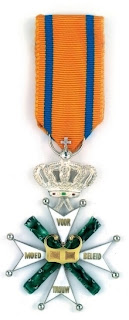 |
| Military Williams Order (fourth class) to the 1st Polish Independent Parachute Brigade |
 | |
| Banner of the 1st Polish Independent Parachute Brigade |
NAJKROTSZA DROGA
BY THE SHORTEST WAY
Fantastic article that gives some justice to what the Polish heroes suffered. I am proud to be of Polish descent and born in Great Britain, however I just wish the British would recognise properly the vast effort made by Poland during WW2.
ReplyDeleteIt is unworthy and unbecoming of the British Government not to recognize posthumously the achievement of General Sosabowski and that appaling treatment of him both by General Montgomery some of his staff and the successive British Governments until today 30.08.2017. It will be 73 years since this fiasco by the British High Command and still the British Government has not got the guts to admit that General Sosabowski was treated shabbily by the British and recognize this fact by a posthumous award (albeit belatedly). There is always time to put past 'wrongs' right. A lot of lives were lost because of Montgomery's ineffective planning. Shame on those who allowed and continue to allow this injustice to continue. General Sosabowski received no Army Pension and died in penury. So much for 'Great' Britain.
ReplyDeleteMichael Myers
I don't know if my last attemp to comment worked. Here goes again. I agree completely. Gen Sosobowski was treated with vindictiveness because we suspect of his correct prediction re Montys Operation Marketgarden butt as I understand it they "got" at him over faux criticism re Falais Salient and the role the Polish Troops played in closing the noose. That's as I understand it. But I ask. Was Hugh Diwding treated any better after the Battle of Britain? Speaking of which Clement Atlee kowtowing to Stalin and denying Polish Arned forces the right to march in the victory march in London? Notwithstanding these other examples Gen Sosobowski deserved better when he was alive and deserves recognition finally in the UK
ReplyDelete